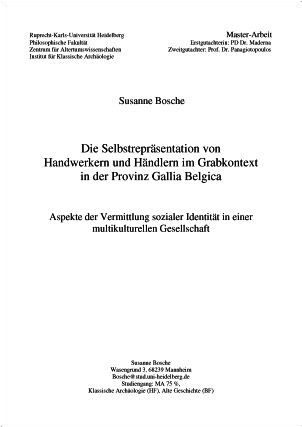
How to Cite
Published
Downloads
Die Selbstrepräsentation von Handwerkern und Händlern im Grabkontext in der Provinz Gallia Belgica
Aspekte der Vermittlung sozialer Identität in einer multikulturellen Gesellschaft
The study at hand focusses on the analysis of the social background underlying the self-representation of crafts- and tradesmen in the context of graves in the Roman province Gallia Belgica during the 2rd and 3rd centuries AD. It also deals with conceivable phenomena stemming from an enhanced contact between the local population and Roman culture. In the first part of the study it is suggested that the high number of stone grave monuments for crafts- and tradesmen found for the period in question seemingly needs to be considered in the context of changes in memorial culture and of materials used, and that it cannot be ascribed to only social or economic factors.
The grave monuments’ iconographic design, which is analyzed with regard to their economic aspects in the second part of the study, does not indicate a stabilization of the visual language that could have been read as the expression of a collective identity. The conceptual background of the representativeness of craftsmanship and trade is defined by the production of goods of high and verifiable quality. At the same time the trans-regional transport of goods was more important for this consideration than their actual sale. This was because not the exchange of goods for money, but the interaction with clients was of priority. The third part of the study deals with the social classification of the respective individuals. This is possible only to a limited extent: The individuals’ legal status in particular cannot be reconstructed in a conclusive manner. Their names and clothes, however, suggest that they predominantly must have been members of the local population. The grave monuments, that were highly heterogenic in their forms, indicate a claim for social prestige - among other tendencies concerning the expansion of technical demands in memorial construction in the context of commemorative culture. In many cases this claim is being combined with the characterization of the respective individual through the inclusion of prestige goods. The thus identifiable claim for prestige coincides with a tendency for an increased orientation to elements of Roman culture. Due to the lack of studies addressing political ambitions and phenomena discernable in the economic sphere, it should be assumed that internationality was established at least partially as a social value.






